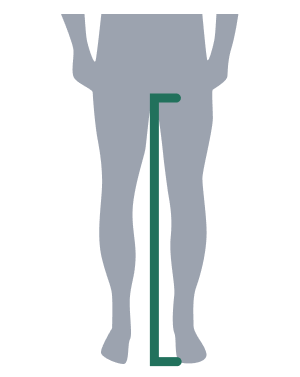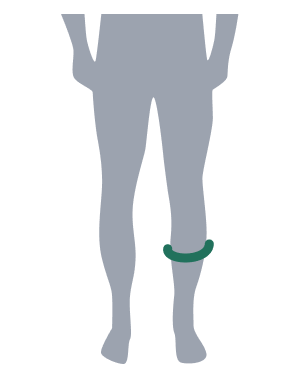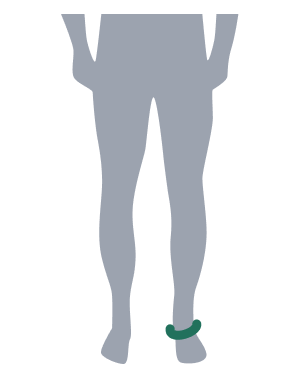Skin and body care
Common Questions
This depends on where you have lymphedema, as it’s important to position yourself in such a way that the lymph can drain. So, if your arm is affected, keep it comfortably elevated (ensuring that it stays below shoulder-height) by resting it on a pillow. If your leg is affected, you’ll either want to recline with your legs up, or sit with your leg up on a chair or ottoman, ensuring that you are supporting your knee with a cushion or pillow. And avoid sitting with your legs crossed. Finally, if you have lymphedema in your head/neck, you should sleep with your head elevated to help the fluid drain. You can do this either by sleeping with a foam wedge or a special pillow, or by elevating the head of the bed. In any case, you should avoid being stationary for long periods of time. It’s a good idea to get up and move around at least once an hour if you are able to do so.
It’s a good idea to always try to wear comfortable shoes, particularly if you will be standing for a long time. If you can, perform heel raises, as that will help activate your calf muscles. You can also shift your weight from side to side and from heel to toe. If you are able to, try to do some walking and moving around—even a little bit. Additionally, make sure you wear your compression garment as recommended by your healthcare provider.
Choose comfortable, loose-fitting clothing. Avoid anything that is tight or doesn’t allow you to move freely. This includes socks, stockings, and underwear.
Contact your healthcare provider right away.
Though not everyone will have the same symptoms, you may feel as though you are coming down with the flu. You may have a fever, chills, nausea, aches and pains, and a rash that will develop on the swollen area of the body. You may observe increased swelling, redness, tenderness, and warmth in the area. And depending on the affected limb, there may also be some involvement in the groin or the armpit.
Cellulitis is an infection of the skin. It can result from a burn, bite, or break in the skin, or may arise without any known injury. Symptoms of cellulitis may include increased swelling, redness, tenderness, and warmth in the area, which may also be accompanied by flu-like symptoms, nausea, or vomiting. It is important to contact a healthcare provider right away, as cellulitis requires treatment with antibiotics.
If you notice any symptoms of infection or suspect you may have an infection, contact your healthcare provider right away
You may notice an area is painful, red, and warm. There may also be more swelling than usual. An elevation in temperature, flu-like symptoms, or red streaks going up or down from a cut or break in the skin all may be signs of an infection, and you should contact a doctor immediately.
In general, try to avoid situations where you are likely to damage your skin. Wear sunscreen, insect repellent, and protective clothing when outdoors or hiking, and take care with cooking or baking. If you do get a cut, burn, or bite, clean the area immediately with water, and apply an antibiotic ointment and a bandage or dressing. Consult your healthcare provider if the area does not seem to be healing, or if you notice any signs of infection.
Sun exposure can elevate skin temperature and cause blood vessels to dilate, resulting in increased swelling. It is important, therefore, to always protect the skin from the sun. Wearing light, comfortable clothing and using a good quality sunscreen can help prevent damage to the skin.
When caring for fingernails and toenails, it’s important to keep the risk of infection to a minimum. Therefore, be careful when trimming your nails so as to avoid cutting your skin or clipping the nails too short. You’ll also want to keep your fingernails clean. A soft nailbrush will work to clean under your nails.
There are differing opinions on shaving. Most people recommend using an electric shaver to eliminate the risk of nicks and cuts. Chemical depilatories and waxing may damage skin that is already fragile, and so those methods of hair removal are not recommended.
It is best to avoid both extreme heat and extreme cold, as they can make swelling worse.
Typically, you can use any hypoallergenic fragrance-free moisturizer. Those with dry skin or other skin problems can discuss the best skin care product options with a healthcare provider.
Those with lymphedema are at risk of a skin infection called cellulitis. Any break in the skin increases the likelihood of bacteria entering and causing an infection. It’s therefore important to care for the skin and protect against injury. The skin may also be dry and itchy, and scratching can cause breaks in the skin.
The information provided in this article is for informational purposes only. It is not a substitute for professional medical advice, diagnosis, or treatment. Always seek the advice of your doctor or another health care provider if you have any questions about a medical condition or treatment, and do not disregard your doctor’s advice because of any information provided on this site. If you think you may have a medical emergency, immediately contact your doctor or call 911.
Can’t find what you’re looking for?

Stay connected to all the Aria Health news. You’ll also receive updates, offers, and details about feedback opportunities. We’re doing something different, together.

![]()
![]() Previous
Previous
Calculate Size ![]()
![]()

While standing, measure the inside of your leg from the bottom of your heel to your groin.

Measure around the widest part of your thigh.

Measure around the widest part of your calf.

Measure around the widest part of your ankle.

Yes, let's go! ![]()
![]()
Not yet, want to learn more

We’re expanding as quickly as we can to serve all patients.

We’re expanding as quickly as we can to serve all patients.

Yes, let's go! ![]()
![]()
Not yet, want to learn more
Calculate Size
Cancel

While standing, measure the inside of your leg from the bottom of your heel to your groin.

Measure around the widest part of your thigh.

Measure around the widest part of your calf.

Measure around the widest part of your ankle.